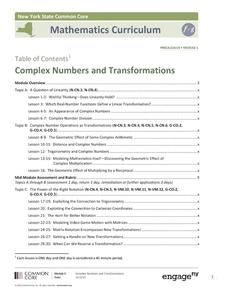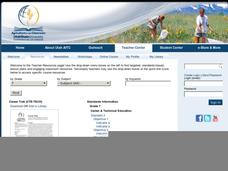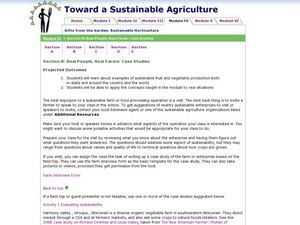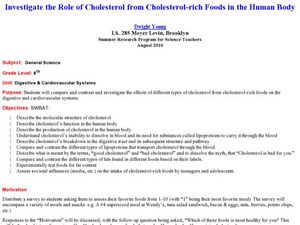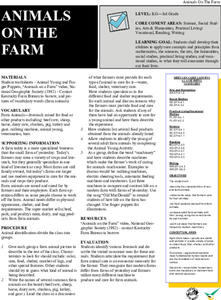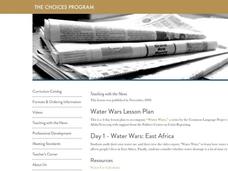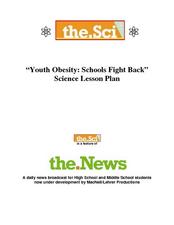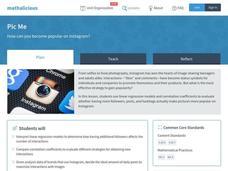Curated OER
Clothes on the Grow
Can you grow clothes? Sure, wool, cotton, and Angora are all natural resources used to make textile products. Learners investigate the differences between synthetic and natural fibers, then consider textile processing careers. They watch...
Baylor College
Energy Sources
Take the concept of burning calories to a more literal level in the second of seven lessons about energy in the realm of food and fitness. Using simple materials, groups will burn breakfast cereal and a pecan to see which one gives off...
EngageNY
Complex Numbers and Transformations
Your learners combine their knowledge of real and imaginary numbers and matrices in an activity containing thirty lessons, two assessments (mid-module and end module), and their corresponding rubrics. Centered on complex numbers and...
Curated OER
Career Trek: Agricultural Careers
What is agriscience and could it hold a potential career opportunity? Learners define agriscience and explore careers that involve both agriculture and natural resource fields. The lesson includes several web links, a game, a full...
Curated OER
DNA: Expressions in Agriculture
What is DNA extraction, and can you make a living doing it? Yes, if you are in a biotechnology field. Kids learn about DNA extraction, GMOs, and biotechnology careers. They then watch videos and complete activities to understand the use...
Curated OER
A Thin Slice of Soil
Young scholars examine the importance of soil in the production of what we eat and wear, and analyze the percentages of the earth used for food production. They create their own Pyramids of Life, and construct Dirt Babies out of hosiery,...
Curated OER
Nutrition Fest
Students explore the nutritional needs within a particular disease or health condition. They create a a written report, a food product and a sample menu for one week based on nutritional needs. Students create a food package or display...
Curated OER
Hey, Mom! What's for Breakfast?
Students examine how he world eats breakfast. In this food choices lesson, students work in groups to list breakfast foods and their ingredients and find goods and consumers on the list. The, students use the Internet to complete a...
Curated OER
Real People, Real Farms: Case Studies
Students examine sustainable fruit and vegetable production. In this agriculture lesson students apply what they learn to real life situations.
Curated OER
Day Three: Reading menus; writing letters
Learners practice English vocabulary in menus and food items. In this ELL lesson plan, students look at pictures of people eating and describe what they are doing. They talk about the food that they like and dislike and describe why.
Curated OER
Supply Chain Management
Students identify the steps of production. In this supply chain lesson, students determine how businesses monitor production and trace the supply chain of products they own. Students also discuss ethical issues related to the supply chain.
Curated OER
Investigate the Role of Cholesterol from Cholesterol-rich Foods in the Human Body
Eighth graders assess fat content of different food samples. In this biology lesson, 8th graders create a flowchart showing the transport of cholesterol in the bloodstream. They perform tests for the presence of lipids on food samples.
Curated OER
Giving'Em The Business
Young scholars work in groups of 4-5 to form a business, create, market & sell their product, and track their expenses and profits. They experience the roles of producer, distributor, and consumer of goods. They collect, organize...
Curated OER
Animals on the Farm
Students work in groups to create a description of a farm animal. Other classmates try to guess the animal. The class discusses what farmers need to provide for each animal on their farm (food, shelter, veterinary care). Students...
Curated OER
Farm Animals
Why are farm animals important to the community? Expand young farmers' knowledge of furry and feathered friends through stories and a video. There are several books recommended; however, you could use any book about farm animals. A video...
Curated OER
Water Wars
High schoolers investigate the water wars taking place in East Africa. In this global issues lesson plan, students watch video clips and read selected articles about the water shortages in East Africa. High schoolers estimate their own...
Curated OER
How Did That Get in My Lunch?
Learners view "The Danger Zone" to learn about food poisoning and the bacterial causes and prevention. Students look at slides, use a worksheet, "Microbial Bugs"and the internet to identify and learn about each bacterium.
Curated OER
Toward a Sustainable Agriculture
Your class considers a case study of a sustainable agro-ecosystem and view a PowerPoint presentation about a sustainable farm. They complete a case study worksheet. Extension activities are included.
Curated OER
Where's the Beef - Beef Facts or Hype, Is it Bad for You?
Analyze a Happy Meal™ for nutrient content and calories. Blend the contents into "McMush" and use Biuret's solution to test for protein content. There are a few problems with the lesson plan: the resource links are no longer valid, the...
Curated OER
Youth Obesity: Schools Fight Back
Explore nutrition and healthy eating habits with a study on youth obesity. Learners watch a PBS documentary on the obesity epidemic which discusses government programs aimed at healthier choices, as well as more localized efforts. Kids...
Mathalicious
Pic Me!
Finally! Math and Instagram have come together to discuss the correlation between likes and followers. High schoolers can't help but want to discover what makes one account more popular than another by developing a line of best fit and...
Curated OER
The Kindness Company
Students organize themselves into a simulated company complete with applications, interviews and training. They identify a community need they can fulfill related to cooking or sewing and work to make and deliver the designated product.
Curated OER
Happy Habitats
Students explore different habitats. In this habitat lesson plan, students investigate four different habitats through participating in a WebQuest. Students create an animal web using Kidspiration or a video documentary upon completing...
Curated OER
Letters from the Heart: Designing for the Other 90% of the World's Population
Students explore varied aspects of the design process and learn that most products are designed to reach the worlds wealthiest 10%. In this lesson, students work in groups to learn ways in which designers are attempting to rectify this...




